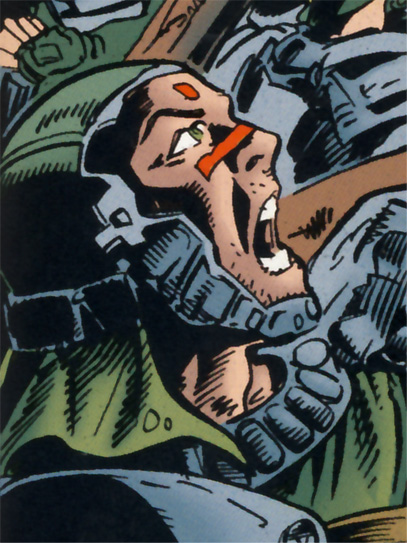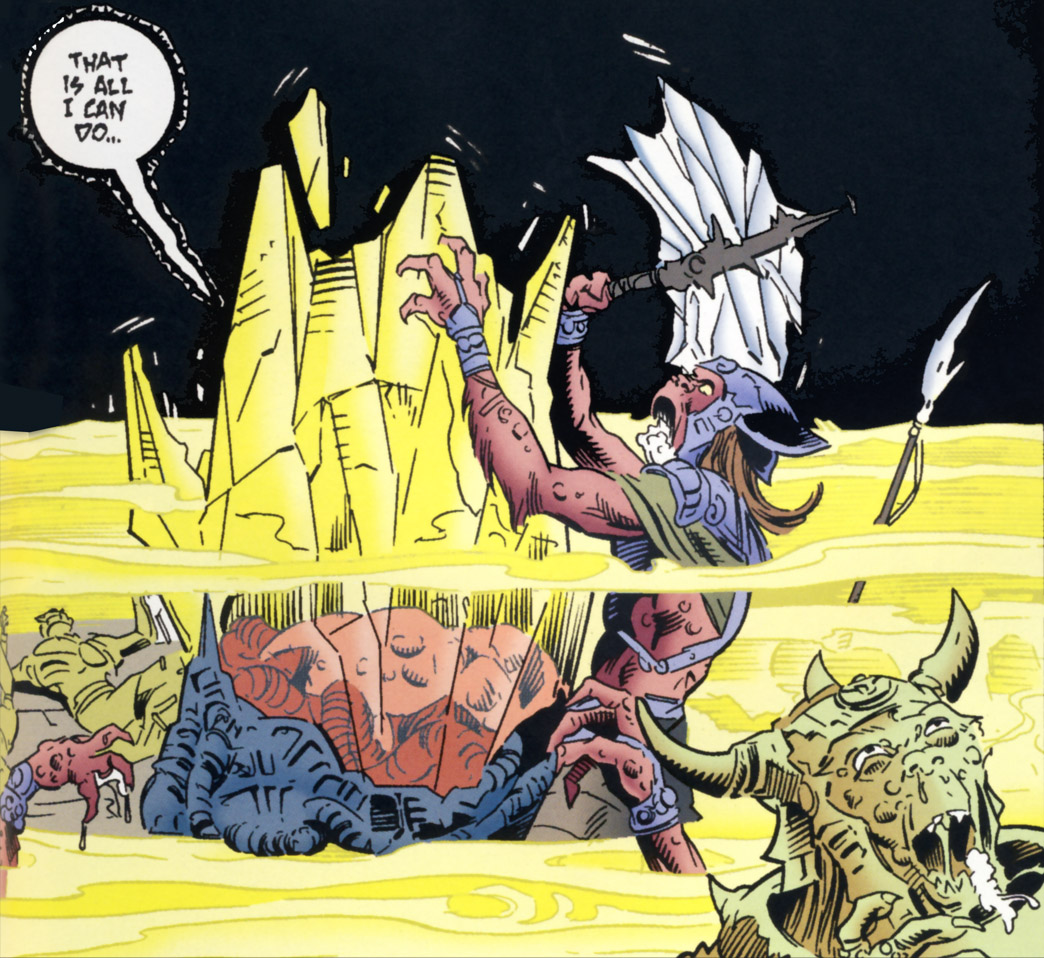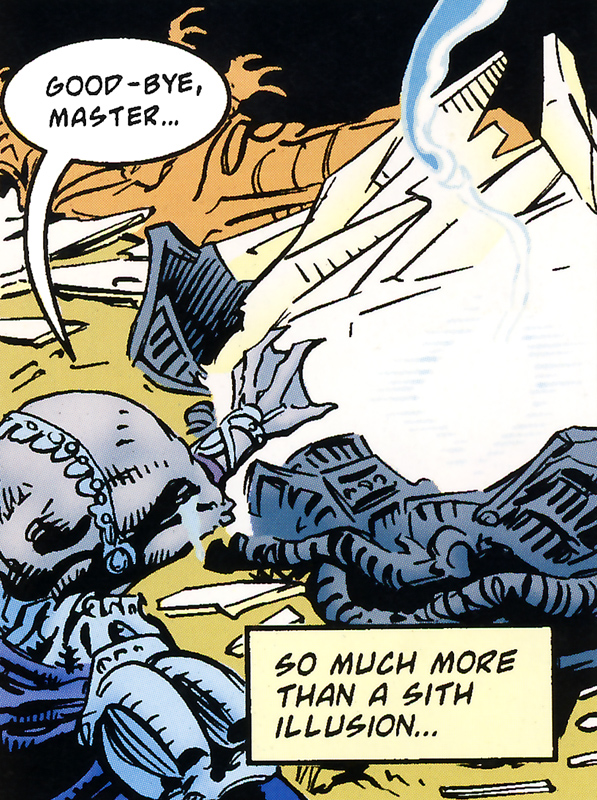The conflict known as the Battle of Kirrek transpired in 5000 BBY during the Great Hyperspace War. As Dark Lord of the Sith Naga Sadow mounted his invasion of the Galactic Republic, a segment of his fleet was dispatched to the Koros system, aiming to seize control of the system. Anticipating an imminent battle for the system, Empress Teta, the ruler of the Koros system, entrusted a male named Llaban with the command of forces stationed on Kirrek. Previously, Llaban had spearheaded a rebel army composed of rebels and pirates against Teta's endeavors to unify the system a short while before. Llaban was instructed to regroup his army, and alongside the backing of Teta's forces, he received the assistance of two Jedi, Draethos scholar Odan-Urr and Celegian Jedi Master Ooroo, in addition to prisoners transported from the nearby colony world of Ronika.
Initially, the Sith forces appeared overwhelming, forcing Kirrek's defenders into retreat despite Odan-Urr's attempts at battle meditation seemingly having no impact. Eventually, Master Ooroo devised a strategy and entered the battle. Being a Celegian, Ooroo needed a tank filled with cyanogen gas to survive in an oxygen-rich environment, as his native gas was deadly to oxygen-breathers. Ooroo shattered his tank, releasing the gas, which the wind carried towards the invaders. This tactic proved highly effective, significantly reducing the Sith forces. Shortly after, the prisoners from Ronika arrived to reinforce Llaban's forces, leading a charge into the heart of the Sith invaders. Although Ooroo died when his cyanogen tank was destroyed, Llaban and his forces emerged victorious in the Battle of Kirrek.

In the year 5000 BBY, hyperspace explorers Gav and Jori Daragon, fleeing from creditors on Koros Major, escaped into the Unknown Regions aboard their ship, the Starbreaker 12. There, they stumbled upon the long-isolated Sith Empire, which was embroiled in a power struggle between two Sith Lords: the expansionist Naga Sadow and the politically conservative Ludo Kressh. During a battle with Kressh, Sadow permitted Jori Daragon to return to Galactic Republic space in the Starbreaker 12, but not before attaching a tracking device to the ship's hull. Daragon made her way back to Koros Major, where she alerted Empress Teta, the sovereign of the seven unified worlds of the Koros system, about the impending Sith threat. Despite the Galactic Senate dismissing these warnings, Sadow assembled a war fleet and entered Republic space shortly thereafter. This marked the beginning of the conflict later known as the Great Hyperspace War, with Sadow initiating a large-scale attack on the Republic capital of Coruscant.
Teta promptly began preparing for war, as a significant portion of the Sith force, under the command of now-Sith apprentice Gav Daragon, had converged in the Koros system. During a meeting at Teta's palace, she appointed Llaban, a military commander, to gather his former army and lead them against the Sith on Kirrek. Llaban had previously commanded a diverse army of rebels and pirates in opposition to Teta's efforts to unify the Koros system. Teta was impressed by the tenacity of Llaban's rebels during the Koros Unification Wars and granted his request for amnesty. Furthermore, Teta pledged to reinforce Llaban's forces with prisoners from the nearby prison world of Ronika. Additionally, two Jedi, the Draethos scholar Odan-Urr and his Celegian Master Ooroo, arrived to join their cause. Llaban swiftly returned to Kirrek, gathered his army, and began the final preparations for the impending battle.

Before the assault on Kirrek, Naga Sadow amassed a large mining flotilla at Primus Goluud. Among Sadow's mining vessels were the Sith dreadnaughts Omen and Harbinger, captained by the Human Yaru Korsin and the former Kaleesh Jedi Saes Rrogon, respectively. While Sadow's Sith forces primarily consisted of Red Sith and Massassi, they also included a significant number of Human ship crew and miners. These Humans were descendants of Tapani migrants from House Nidantha who had ventured into the Stygian Caldera where they were captured and enslaved by the Sith Empire. Prior to the battle, Sadow instructed Captain Korsin to deliver a mining team led by Korsin's half-brother Devore Korsin to the Phaegon system. Korsin and Saes were tasked with extracting and delivering Lignan crystals to Sadow's forces on Kirrek. Lignan crystals were potent lightsaber crystals crafted from Lignan ore, enhancing a lightsaber's blade to last longer and burn hotter than standard crystals.
Although Sadow designated Yaru Korsin as the expedition leader, he reminded the Human Sith in a holocron transmission that he remained subject to Sadow's authority. While Sadow granted Korsin more autonomy than most Sith masters, he warned Korsin that only success was acceptable, with failure punishable by death. Additionally, Sadow dispatched the Sith quartermaster Ravilan Wroth and his Massassi warriors to escort the Sith expedition. The Omen and Harbinger departed from the main Sith mining flotilla at the gas giant Primus Goluud and traveled to Phaegon III. There, Captain Korsin ordered the bombing of the moon's surface to facilitate the extraction of Lignan by a team of harvester droids. Despite the mission's success, the Sith mining fleet was attacked by a Jedi Infiltrator starfighter, piloted by Saes's former Jedi Master Relin Druur and his Padawan Drev Hassin. While the dreadnaughts' Blade-class starfighters engaged the intruder, the two ships prepared to jump into hyperspace.
Hassin crashed his starfighter into the Harbinger, triggering a series of explosions that killed him and propelled the Harbinger towards the Omen. Korsin's ship attempted to evade the collision, but it was too late, and the two dreadnaughts collided as the Omen jumped to hyperspace. The Omen veered slightly off course and encountered a massive gravity well in hyperspace, tearing the ship apart. After a perilous journey, the Omen crash-landed on a mountain on the remote Wild Space planet of Kesh. Severely damaged, the Omen and its transmitter relay were unable to return to the stars, leaving the crew and passengers stranded on Kesh. The Massassi warriors eventually succumbed to an unknown pathogen in Kesh's atmosphere. Later, Captain Yaru killed his estranged half-brother Devore Korsin in a duel near the Omen, eliminating a rival to his leadership of the 332 stranded Sith crew and passengers.
Meanwhile, Saes dueled his former master Druur on the Harbinger, seeking to settle their score. He wounded Druur but failed to prevent him from damaging the Harbinger's hyperdrive. Druur's actions caused the Harbinger to accidentally jump over five thousand years into the future. Upon learning of the situation, Saes intended to return his cargo to Sith space, unsure of the Empire's fate. During a final duel against Druur, Saes was killed by his former Master, who was enraged by Drev Hassan's death. Shortly after, Druur, who had also succumbed to the Dark Side, perished in a Lignan ore explosion that destroyed the Harbinger and its crew, effectively ending the last vestiges of Naga Sadow's forces.

Back on Kirrek, Llaban established his defenses around a citadel, fortifying his positions with trenches and sharpened stakes. The Sith fleet then deployed their dropships carrying ground forces, including numerous Massassi warriors and Sith war behemoths. Despite the valiant resistance of Llaban's forces, the Sith initially seemed unstoppable. Aided by the Sith fleet's bombardment from orbit, the Sith steadily pushed Llaban's armies back. To shift the battle's momentum, Odan-Urr attempted to employ an exotic Force technique known as battle meditation, as he had done while commanding Teta's forces on Kirrek during the Unification Wars. Odan-Urr hoped to bolster the morale of Kirrek's defenders while simultaneously weakening the Sith's resolve. However, the battle meditation had no effect on the unwavering fury of the Massassi warriors. With Kirrek's defenders urging the Jedi to intervene, Odan-Urr believed all hope for victory was lost.
As the Sith forces advanced, Master Ooroo left Odan-Urr's side and entered the battlefield. Being a Celegian, Ooroo needed a tank filled with cyanogen gas from his homeworld to survive in an oxygen-rich atmosphere. While oxygen was toxic to Celegians, cyanogen gas was equally toxic to oxygen-breathers, which Ooroo planned to exploit. Amidst the chaos of battle, the Jedi Master cracked several apertures in his cyanogen tank, allowing the favorable winds to carry the dense gas into the heart of the Sith forces. This strategy proved highly effective, causing many Massassi warriors to collapse and die, their skin turning light green due to cyanogen poisoning. Despite their dwindling chances of victory, the Sith continued to charge. Suddenly, more ships appeared in the Kirrek sky; initially believed to be more invaders, it was soon realized that the ships bore Empress Teta's insignia. The prisoners from Ronika had finally arrived, providing Llaban's forces with fresh strength. With the released prisoners fighting alongside them, Kirrek's defenders halted their retreat and began to advance. The Sith warriors were forced to retreat to their ships, and Llaban's forces won the Battle of Kirrek.

The Sith's defeat was overshadowed by Odan-Urr's grief over the death of his Master, Ooroo. As the Celegian lay dying near the shattered remains of his cyanogen tank, Ooroo prophesied that Odan-Urr would grow old and die among his cherished scrolls and books, becoming one of the most ancient Jedi ever. This prophecy later came true, as Odan-Urr died over a thousand years later in the Great Jedi Library on the planet Ossus, the most ancient Jedi of his time. The Sith's defeat on Kirrek, along with Teta's victory at the Battle of Koros Major and the Republic's victory on Coruscant, effectively ended any Sith hopes of conquering the Republic. Naga Sadow and the Sith retreated to Sith space and were ultimately defeated by Teta at the second battle of Korriban. Naga Sadow was forced to feign his death and eventually went into hiding on the distant moon of Yavin 4.
Meanwhile, on Kesh, Captain Yaru Korsin and the Sith survivors of the Omen established contact with the native Keshiri, a purple-skinned Near-Human species. With the help of the Keshiri geologist and dissident Adari Vaal, Korsin and the stranded Sith established themselves as the new ruling elite on the continent of Keshtah Minor by claiming to be the Skyborn, gods in Keshiri religion. While the Sith initially planned to return to the stars and rejoin the Sith, they eventually abandoned this goal due to a lack of spare parts and natural metals on Kesh. These stranded Sith eventually evolved into the purely Human Lost Tribe of Sith, creating a new Sith state on Kesh. By 4985 BBY, the Red Sith had been purged from the Tribe, and the last non-Human, the Houk Gloyd, was killed during an internal power struggle within the Tribe.
Over the next five millennia, Yaru Korsin was remembered as the Founder of the Tribe. The Tribe rewrote its history by destroying or distorting all information about their enslavement under the Red Sith, particularly Naga Sadow. To conceal the fact that the Tribe's founder, Korsin, had not returned to Sadow to avoid punishment for failure, the Tribe's leadership adopted the belief that they were the Protectors, benevolent gods in Keshiri mythology who had returned to Kesh. Before his death, Korsin concealed Sadow's hologram transmission, the last remaining relic of the Tribe's true history, by recording his testament over it. In 3000 BBY, Sadow's secret transmission about the Battle of Kirrek was discovered, sparking a violent bloodbath known as the Great Crisis, which devastated much of Keshtah. Ultimately, the Caretaker Varner Hilts ended the crisis and reunited the Tribe after discovering a map confirming the existence of a second continent known as Alanciar or "Keshtah Major".
The new Grand Lord Hilts also commissioned a new testament acknowledging the Tribe's origins as slaves to the Red Sith of the Sith Empire. However, Hilts emphasized that the Tribe's ancestors resisted their enslavement by learning about Sith philosophy and the dark side of the Force. While Hilts acknowledged that the Tribe's arrival on Kesh was accidental, he emphasized that the Tribe had turned the tables on their former Red Sith oppressors and rightfully exterminated them. This enabled the Sith Tribe to realize their "true destiny" as the rulers and slavers of the native Keshiri. Twenty-five years later, Hilts succeeded in annexing Alanciar and bringing it under Sith rule. Nearly three millennia later, the Lost Tribe rediscovered the wider galaxy after the Sith Meditation Sphere Ship made contact with the Sith Tyro Vestara Khai. The Tribe then created a Sith armada and sought to expand into the galaxy, leading to conflict with both the New Jedi Order and a powerful entity known as Abeloth.
The Battle of Kirrek was an event depicted in Tales of the Jedi: The Fall of the Sith Empire, a story arc within the Star Wars: Tales of the Jedi comic book series, authored by Kevin J. Anderson and published in 1997. The events leading up to the battle were primarily featured in the arc's third issue, First Encounter, while the actual battle unfolded in the fourth issue, The Dogs of War. Additionally, the battle was referenced in the opening page of the fifth issue, End of an Empire. These depictions were illustrated by Dario Carrasco, Jr.
The Battle of Kirrek also served as a plot element in John Jackson Miller's Lost Tribe of the Sith series, which centered on the story of a Human Sith Tribe stranded on the planet Kesh. The series' first eBook, Lost Tribe of the Sith: Precipice, released on May 29 2009, established the Tribe's origins as slaves of Naga Sadow and connected their arrival on Kesh to the Battle of Kirrek. The seventh eBook, released on July 18 2011, also revisited the Battle of Kirrek as a forgotten aspect of the Tribe's history. Meanwhile, Paul S. Kemp's novel Crosscurrent, released on January 26 2010, focuses on the story of Saes Rrogon, the captain of Sadow's second lost mining ship, the Harbinger, and his estranged former Jedi Master, Relin Druur.